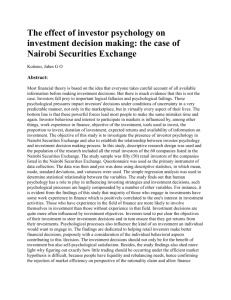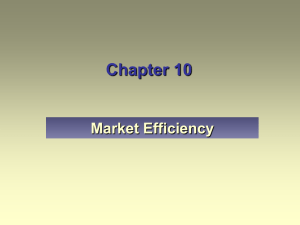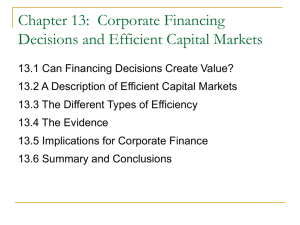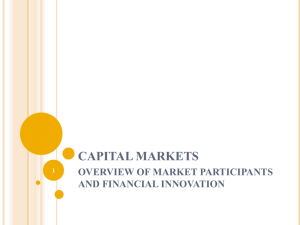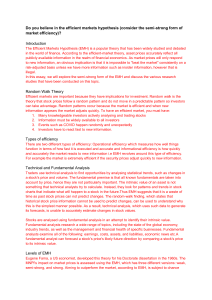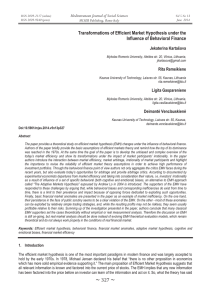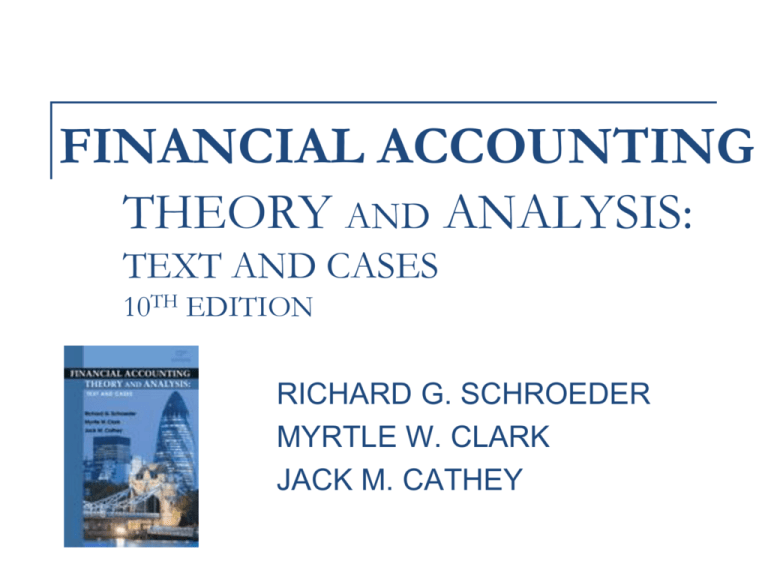
FINANCIAL ACCOUNTING
THEORY AND ANALYSIS:
TEXT AND CASES
10TH EDITION
RICHARD G. SCHROEDER
MYRTLE W. CLARK
JACK M. CATHEY
Chapter 4
Research Methodology And
Theories On The Uses Of
Accounting Information
Introduction
To have a science is to have a recognized domain and a set of
phenomena in that domain
Theory describes the underlying reality of that domain through input
(observations) and outputs (predictions)
INPUTS
OBSERVATIONS
OUTPUTS
PREDICTIONS
Very little behavior is explained through existing accounting theory
Theory vs theorizing
Chapter introduces methods of developing theory and some theories on
outcomes of providing accounting information
Research Methodology
Deductive approach
Inductive approach
Pragmatic Approach
Scientific Method
Other
Deductive Approach
Essentially an “armchair” approach
Going from the general to the specific
Begins with the establishment of objectives
Next definitions and assumptions are stated
A logical structure for accomplishing the objectives based on
the definitions and assumptions is developed
Attempts to “theorize are generally based on the deductive
approach
Validity of this approach lies in the researcher’s ability to relate
components
If researcher is in error, conclusions will also be erroneous
Inductive Approach
Making observations and
drawing conclusions
Generalizations are made about
the universe based upon limited
observations
APB Statement No. 4 utilized
the inductive approach
Pragmatic Approach
Based upon the concept of utility or usefulness
When a problem is found…
an attempt to find a solution is undertaken
Most accounting theory was developed using this
approach
A Statement of Accounting Principles was a
pragmatic approach
The Scientific Method
Involves the following steps:
Draw a tentative conclusion
Analyze and evaluate data
Collect data necessary to test the hypotheses
State the hypotheses to be tested
Identify and state the problem to be studied
Most accounting research found in academic journals uses
the scientific method
Other Research Approaches
Ethical approach
– Developed by DR Scott and involves the
concepts of truth, justice and fairness
Behavioral approach
– The study of how accounting information
affects the behavior of users
The Outcomes of Providing
Accounting Information
Fundamental analysis
The efficient market hypothesis
The capital asset pricing model
Normative vs positive accounting
theory
Agency theory
Human information processing
Critical perspective research
Fundamental Analysis
Investor decisions
- Buy
- Hold
- Sell
The goal of fundamental analysis
Investment analysis
The Efficient Market Hypothesis
Holds that fundamental analysis is not a useful tool…
because individual investors are not able to identify
mispriced securities
The Efficient Market Hypothesis
Based on the free market supply and demand
model with the following assumptions:
– All economic units have complete knowledge of the
economy
– All goods and services are completely mobile
– All buyers and sellers are so small in relation to total
supply and demand that neither has an influence on
supply or demand
– No artificial restrictions on demand, supply or prices of
goods and services
The Supply and Demand Model
Price
Supply
Demand
Quantity
The Supply and Demand Model
Best illustrated in the securities market
Information available from many
sources including:
1
2
3
4
5
6
Published financial reports
Quarterly earnings reports
News reports
Published competitor information
Contract awardings
Stockholder meetings
The Efficient Market Hypothesis
According to the supply and demand
model, the price of a product is
determined by knowledge of
relevant information
The securities market is viewed as
efficient if it reflects all available
information and reacts
immediately to new
information
The Efficient Market Hypothesis
The EMH indicates that an investor
with a diversified portfolio cannot make an
excess return by knowledge of available
information
There are three forms of the EMH which differ in
respect to the definition
of available information
– Weak form
– Semi-strong form
– Strong form
Weak Form
An extension of the random walk theory in the
financial management literature
The historical price of a stock provides an unbiased
estimated of its future price
Consequently, an investor cannot
make an excess return by
knowledge of past prices
This form of the EMH has been
supported by several studies
Semi-Strong Form
All publicly available information including past prices is
assumed to be incorporated into the determination of
security prices
An investor cannot make an excess return by knowledge
of any publicly available information
Implication is that the form of disclosure, whether in the
financial statements, the footnotes, or financial press
information is not important
This form of the EMH has been generally supported in the
literature
Strong Form
All available information,
including insider information is
immediately incorporated into the
price of securities as soon as it is
known leaving no room for
excess returns
Most available evidence suggest
that this form of the EMH is not
valid
Challenges
2008 market crash
Efficient Market Hypothesis:
Implications
Lack of uniformity in accounting principles may
have allowed corporate managers to manipulate
earnings and mislead investors.
How are earnings and stock prices related?
Do changes in accounting principles
affect stock prices?
The Capital Asset Pricing Model
The goal of investors is to minimize risk and maximize
returns.
The rate of return on stock is calculated:
Dividends + increases (or - decreases) in value
Purchase Price
The Capital Asset Pricing Model
Risk:
The possibility that actual returns will deviate from expected
returns
U. S. treasury bills
A risk free investment
Return on these investments is the risk free return
Diversification
Stocks can be combined into a portfolio that is less risky than any
of the individual stocks
The Capital Asset Pricing Model
Types of risk are company specific and
environmental
Unsystematic risk
The risk that is company specific
and can be diversified away
Systematic risk
The nondiversifiable risk that is related to
overall movements in the stock market
Financial information about a firm can
help determine the amount of systematic
risk associated with a particular stock
The Capital Asset Pricing Model
Assumption is that investors are risk
aversive and will demand higher returns
for taking greater risks
Beta (b)
The measure of the relationship of a particular stock with the
overall movement of the stock market
viewed as a measure of volatility - a measure of risk
Securities with higher bs offer greater returns than
securities with relatively lower bs
The Relationship Between
Risk and Return
Rs = R f + Rp
Where:
Rs = Expected return on a given risky
security
Rf = The risk free return rate
Rp = The risk premium
The Relationship Between
Risk and Return
Investors will not be compensated for
bearing unsystematic risk since it can be
diversified away
The only relevant risk is systematic risk
β = measure of the parallel relationship of
a particular common stock with the overall
trend in the stock market
Stock’s sensitivity to market changes
Measure of systematic risk
Incorporating Risk Into the Equation
β = :Rs = Rf + βs (Rm - Rf)
Where:
Rs = the stock’s expected return
Rf = the risk-free return rate
Rm = The expected market rate as a whole
β = The stock’s beta
calculated over some historical period
Implications of CAPM
A security’s price will not be
impacted by unsystematic risk
Securities with higher bs (higher risk) will be priced relatively
lower than securities offering less risk
Research has indicated that past
bs are a good predictor of future
stock prices
Criticized because it causes
managers to seek only safe
investments
Normative vs. Positive theory
Normative theory – based upon a set of goals
that its proponents maintain prescribe the
ways things should be.
Must be accepted by the entire universe to be
useful
Positive theory – attempts to explain
observed phenomena
One positive theory is termed agency theory
Positive Theory
Agency theory
Based on economic theories of
Prices
Agency relationships
Public choice
Economic regulation
Positive Theory
Agency theory is based on the
assumption that individuals act to
maximize their own expected utilities.
As a result the relevant question is:
What is a particular individual’s expected benefit
from a particular course of action?
An agency is a consensual relationship between two parties whereby
one agrees to act on behalf of the other
Inherent in this theory is that there is a conflict of interest between the
shareholders and the managers of a corporation
Positive Theory
Agency relationships involve costs to the principles
1 Monitoring expenditures by the
principal
2 Bonding expenses by the agent
3 Residual loss
Agency theory holds that all
individuals will act to maximize their own utility
Monitoring and bonding costs will be incurred as long as they
are less than the residual loss
Human Information
Processing
Annual reports provide vast amounts of information
Disclosure of information is intended to help
investors make buy - hold - sell decisions
Human Information Processing
HIP studies
Studies attempting to assess an individual’s ability to use
accounting information
Results - individuals have limited ability to process large
amounts of information
Consequences:
Selective perception
Difficulty in making optimal decisions
Sequential processing
Implications - extensive disclosures now required may
be having opposite effect
Critical Perspectives Research
Previous theories assumed that knowledge of
facts can be gained by observation
This area of research contests the view that
knowledge of accounting is grounded in
objective principles
Belief in indeterminacy - the history of
accounting is a complex web of economic,
political and accidental consequences
Critical Perspectives Research
Accountants have been unduly
influenced by utility based marginal
economics that holds:
Profit = efficiency in using scarce resources
Conventional accounting theory equates normative
and positive theory.
What should be and what is are the same
Critical Perspectives Research
Critical perspective research concerns
itself with the ways societies and
institutions have emerged.
Three assumptions:
1 Society has the potential to be what
it isn’t
2 Human action can help this process
3 Critical theory can assist human action
Accounting Research, Education
and Practice
How are research, education and practice
related in most disciplines?
For example, medicine?
How are they related in accounting?
Recent frauds have resulted in new
schools of thought
End of Chapter 4
Prepared by Kathryn Yarbrough, MBA
Copyright © 2011 John Wiley & Sons, Inc. All rights reserved.
Reproduction or translation of this work beyond that permitted in
Section 117 of the 1976 United States Copyright Act without the
express written consent of the copyright owner is unlawful. Request
for further information should be addressed to the Permissions
Department, John Wiley & Sons, Inc. The purchaser may make backup copies for his/her own use only and not for distribution or
resale. The Publisher assumes no responsibility for errors,
omissions, or damages, caused by the use of these programs or from
the use of the information contained herein.



